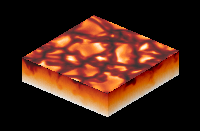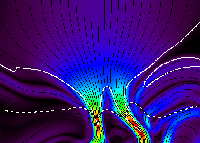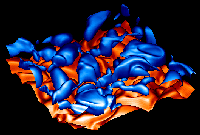




The surface layers of cool stars, including the Sun, are governed by convection. Modeling cool stellar atmospheres requires a detailed treatment of the complex interplay between hydrodynamical flows and radiative cooling. CO5BOLD (COnservative COde for the COmputation of COmpressible COnvection in a BOx of L Dimensions, L=2,3) is one of the few radiation hydrodynamics codes designed specifically for realistic numerical simulations of the convective surface layers and atmospheres of cool stars. The resulting 3-dimensional (3D) model atmospheres are suitable for a direct comparison with real stellar atmospheres, and may be used for the calculation of synthetic spectra.
Starting from the Sun, a grid of 3D CO5BOLD model atmospheres has been computed for solar-like stars with a wide range of metallicities. In addition, CO5BOLD has been used to study convection in stars as diverse as White Dwarfs, Brown Dwarfs, Red Giants, Supergiants, and AGB stars. Science applications range from the investigation of basic physical mechanisms responsible for wave excitation and heating stellar chromospheres to 3D corrections for spectroscopic abundance determinations. 3D non-LTE line formation has been applied to analyze the 6Li / 7Li isotopic ratio in metal-poor stars.
A 3-D radiation chemo-magneto-hydrodynamics code
CO5BOLD solves the time-dependent hydrodynamic equations coupled
with the radiative transfer equation for a compressible plasma in a constant
gravitational field on a Cartesian grid in two or three spatial dimensions.
Operator splitting separates (magneto-)hydrodynamics, 3-D tensor viscosity,
and radiative transfer. A realistic equation of state accounts for partial
ionization and the formation / dissociation of molecules (including CO).
The radiative opacities can be either gray or frequency dependent via an
opacity-binning scheme.
Optional modules allow for the treatment of non-equilibrium processes like
time-dependent dust formation, hydrogen ionization, or molecule formation in
a chemical reaction network. Parallelization with OpenMP is currently the only
option.
Magneto-hydrodynamics
CO5BOLD allows simulations with and without magnetic fields.
The code is capable of modeling transonic flows with shock waves, a ubiquitous
phenomenon in the atmospheres of many stars.
The pure hydrodynamics scheme for non-magnetic simulations is based on a
finite volume approach using an approximate Riemann solver of Roe
type. Recently, the numerical scheme has been improved significantly to
increase the accuracy and stability of the solution, both for high and low
Mach number flows; artificial viscosity is needed only in extreme situations.
The numerical treatment of the MHD equations is considerably more demanding
than the solution of the pure hydrodynamic problem. Currently, the MHD module
of CO5BOLD relies on a particular HLL solver that guarantees the
positivity of the gas pressure and density, and on a flux-interpolated
constrained-transport method ensuring the divergence-free condition of
the magnetic field.
Radiative transfer
The purpose of the radiative transfer modules implemented in
CO5BOLD is to compute for each time step
the net radiative contribution to the energy change per grid cell.
Basically, what needs to be computed is the angle-averaged intensity
at the center of each grid cell.
The standard radiative transfer scheme is based on
long characteristics combined with a Feautrier approach for solving
the transfer equation. This long characteristics solver is optimized
for ''local box'' simulations, representing a tiny fraction of the
stellar surface (e.g. used for simulation of the solar granulation).
It assumes that the radiative flux is primarily transported in the vertical
direction, and relies on periodic lateral boundaries.
Alternatively, CO5BOLD can also be used for modelling a
whole star, e.g. a
whole red supergiant
or a
rotating mini Sun
.
For this global ''star-in-a-box'' setup, a different radiative transfer
module has been developed that is capable of handling geometries without a
preferred direction and with all-open boundaries. This scheme makes use
of short characteristics, and ensures high stability even if the stellar
surface is poorly resolved.
Non-equilibrium ionization
A detailed treatment of the time-dependent ionization of hydrogen (and other
elements) is important for atmospheric layers where significant deviations
from ionization equilibrium prevail, e.g. in the solar chromosphere.
As first important steps towards a realistic description of the upper
atmospheric layers, non-equilibrium ionization is presently implemented
for hydrogen and calcium, albeit without back-coupling to the hydrodynamics.
A consistent implementation of this important feature is currently under
development.
Chemistry
A special-purpose chemical reaction network has so far been implemented in
CO5BOLD. As a first application, the time-dependent formation and
dissociation of carbon monoxide (CO) in the solar atmosphere has been followed
using a reaction network with 7 chemical species and a representative metal,
connected through 27 chemical reactions. The resulting CO concentrations have
been used for a self-consistent treatment of the radiative cooling due to CO
lines in the infrared spectral range, to study the influence of CO on the
thermal structure of the upper atmosphere (COmosphere).
Dust
If the atmospheric temperatures are low enough, not only molecules but larger
particles -- dust -- can form.The formation of dust clouds in cool stellar
atmospheres is a non-equilibrium process. The dust formation module of
CO5BOLD computes the time-dependent formation / destruction of
dust particles and the related modification of the radiative opacities.
The present dust module is designed specifically for simulations of AGB stars
and cool Brown Dwarfs.
Furture directions
MPI parallelization (HD, RT, MHD), MHD module: stability and boundary
conditions, option for finite magnetic diffusivity; Radiative transfer:
option for scattering, opacity distribution
functions?
More information
CO5BOLD User Manual